 It's about time you got here Clarence Joe—I'm like to die of desperation. 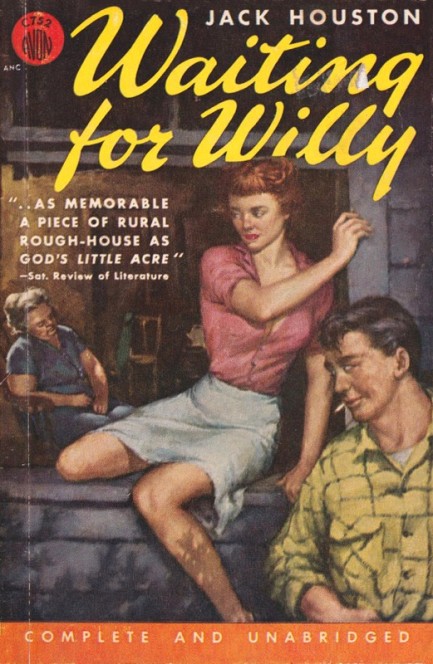
We can't tell you for sure, since Jack Houston's 1952 novel Waiting for Willy dates from well before were born, but we suspect “willy” was a slang term for penis even back then. We think so only because we keep finding what we thought were contemporary slang terms in these old books. We wish we'd thought before now to make a list. You'd be surprised. Apart from some hip-hop expressions—and even including many of those—the slang already existed and was used in the same context. Of course, authors often borrowed terminology from early- and mid-century African American vernacular, which makes the whole process circular, sort of. We'll wait for a comprehensive study on the subject from you linguists out there, and as the cover shows, anticipation is the best part. The art on this is by George Erickson, who you can see more of by clicking his keywords below.
 That bucket of water weighs thirty pounds but she handles it like a basket of muffins. Marry that girl, son. Household drudgery will be a breeze for her. 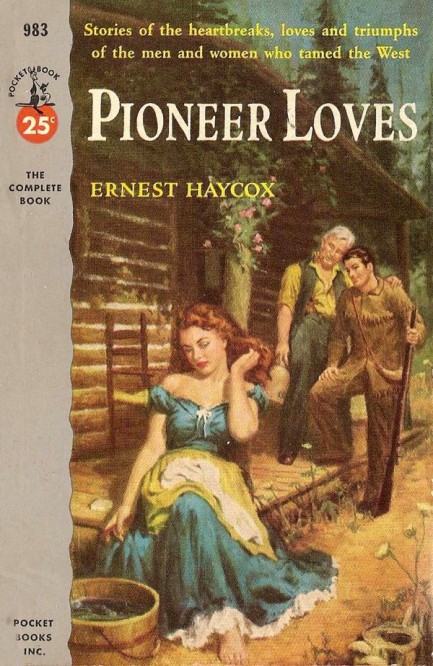
Ernest Haycox was a leading western and historical author. Above you see a cover for his 1954's short story collection Pioneer Loves. He died in 1950, with this appearing posthumously. We don't read many westerns, but by most accounts he was top level. We're featuring it today because the cover art by George Erickson fits a collection we put together last year. The group depicts rural women working hard while their men mostly stand by doing nothing. The Pulp Intl. girlfriends' reaction: “Typical!” Typical, eh? Who makes the seared duck with Pedro Ximénez sauce and mashed parsnips? That would be us. Who dispenses back rubs upon (daily) demand? Us again. Who handles panicked calls for humane evictions of spiders? That's right—us. Never let them diminish your worth, guys.
 That was amazing when you started moaning, “Jack, Jack,” right at the end. My name's Robert, by the way. 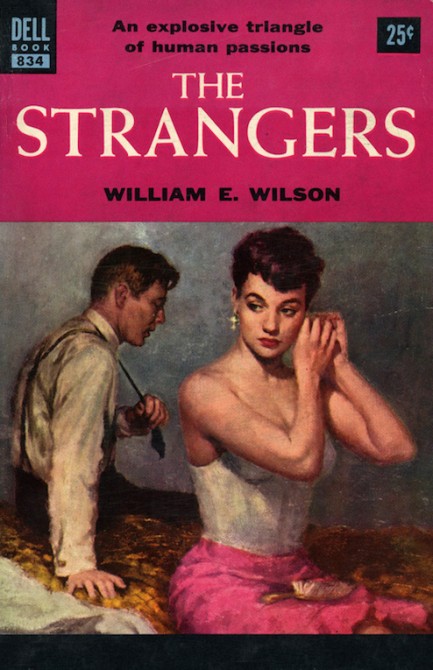
Above, a George Erickson cover for The Strangers, by William E. Wilson, copyright 1955. The book concerns a man, his dissatisfied wife, and the love triangle that results, which sounds like solid sleaze, but this is actually literary fiction from a serious author. Wilson became known as an anti-racism voice during his day. His first novel, Crescent City, is focused on the Ku Klux Klan, and one of his noted works is the autobiographical essay, “Long, Hot Summer in Indiana,” set during 1924, when the Klan was ascendant. The Stranger wasn't rapturously received, but we think Wilson is a good writer, so we may check out Crescent City. If we do, we'll report back.
 Whew! What a swim. I love this isolated old cottage. No stress, no phone, all the problems of the world just gone... 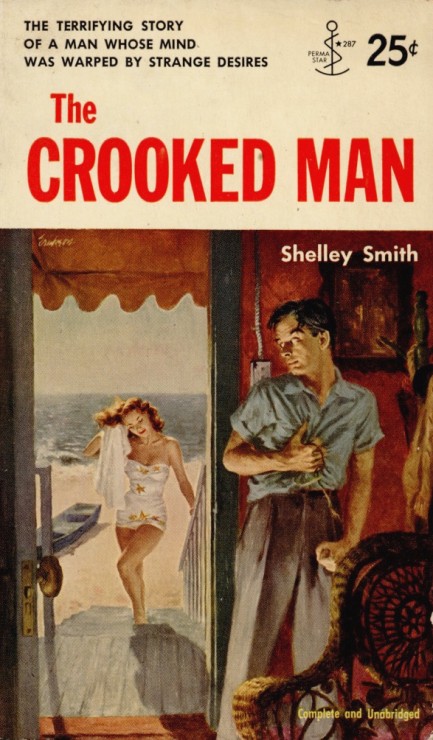
The Crooked Man, written by Shelley Smith for Doubleday & Co.'s Perma Star subsidiary, is the story of a man who survives by cheating people out of their money. Technically he'd be considered a serial killer, but only goes that far if there's no other way. Other times he relies on more complex methods such as marrying to get at women's dowries or bank accounts. His various schemes go fine until—spoiler alert—they don't, and the past comes back to undo him. It was first published in 1952 as Man Alone, and appeared as the above in 1954. The art, which we love, is by George Erickson, whose consistently excellent work we've shared previously here and here.
 Next time he should try thinking about baseball. 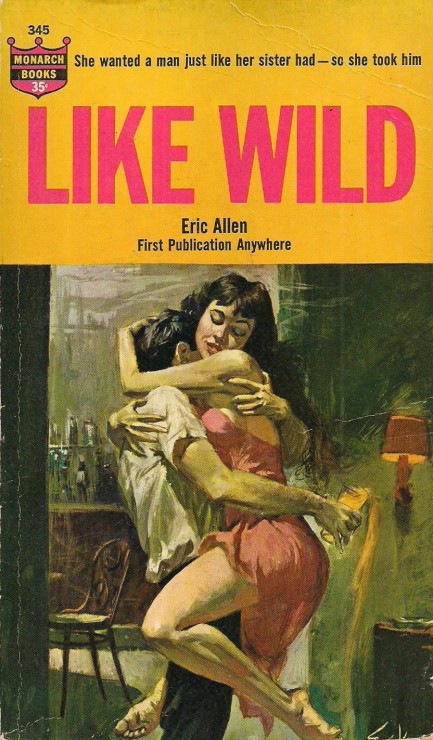
Above is a nice piece by George Erickson for Eric Allen’s Like Wild. It’s the story of a soldier of fortune who returns from Laos to find that his patch of land in Florida is coveted by a local villain. Complicating matters is the villain’s wife, who is a seductress with no qualms about a little action on the side. You know the drill. You may also notice the rather Freudian aspect of the art—i.e., the female figure wraps herself around the male figure in a sexual style embrace that causes his, er, drink to overflow onto the carpet. Well, the stain will come out with water and soap, hopefully. Top marks on this one.
 A silk sash, a tight knot, and gravity equal suicide. Or do they equal murder? 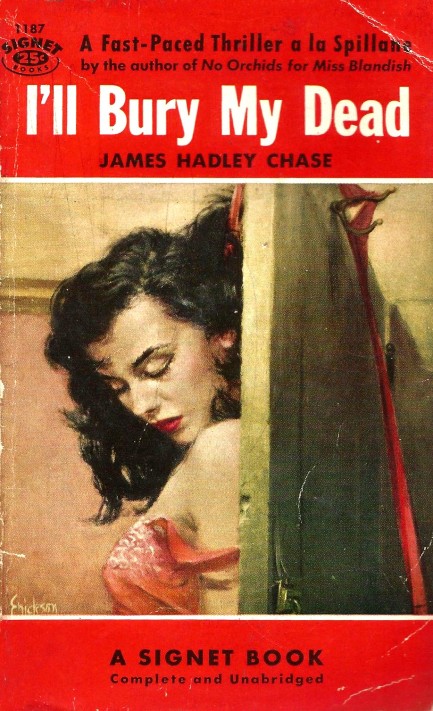
Above you see the cover of British author James Hadley Chase’s 1953 revenge thriller I’ll Bury My Dead. It has what we consider unusually downbeat art, but with the body count in the story being so high maybe that’s to be expected. Basically, a shady P.I. dies of an apparent gun suicide, but his brother is convinced it’s murder and decides to investigate. He ends up uncovering a blackmail racket, getting on the wrong side of the police, and being connected to more corpses, including that of his brother’s wife, depicted in George Erickson’s cover art. Were these murders or suicides? This book was savagely reviewed for the most part but was reprinted as recently as 2009, which goes to show that pulp is critic proof.
|
 |

The headlines that mattered yesteryear.
1939—Holiday Records Strange Fruit
American blues and jazz singer Billie Holiday records "Strange Fruit", which is considered to be the first civil rights song. It began as a poem written by Abel Meeropol, which he later set to music and performed live with his wife Laura Duncan. The song became a Holiday standard immediately after she recorded it, and it remains one of the most highly regarded pieces of music in American history. 1927—Mae West Sentenced to Jail
American actress and playwright Mae West is sentenced to ten days in jail for obscenity for the content of her play Sex. The trial occurred even though the play had run for a year and had been seen by 325,000 people. However West's considerable popularity, already based on her risque image, only increased due to the controversy. 1971—Manson Sentenced to Death
In the U.S, cult leader Charles Manson is sentenced to death for inciting the murders of Sharon Tate and several other people. Three accomplices, who had actually done the killing, were also sentenced to death, but the state of California abolished capital punishment in 1972 and neither they nor Manson were ever actually executed. 1923—Yankee Stadium Opens
In New York City, Yankee Stadium, home of Major League Baseball's New York Yankees, opens with the Yankees beating their eternal rivals the Boston Red Sox 4 to 1. The stadium, which is nicknamed The House that Ruth Built, sees the Yankees become the most successful franchise in baseball history. It is eventually replaced by a new Yankee Stadium and closes in September 2008.
|

|
|

It's easy. We have an uploader that makes it a snap. Use it to submit your art, text, header, and subhead. Your post can be funny, serious, or anything in between, as long as it's vintage pulp. You'll get a byline and experience the fleeting pride of free authorship. We'll edit your post for typos, but the rest is up to you. Click here to give us your best shot.

|
|
















































































